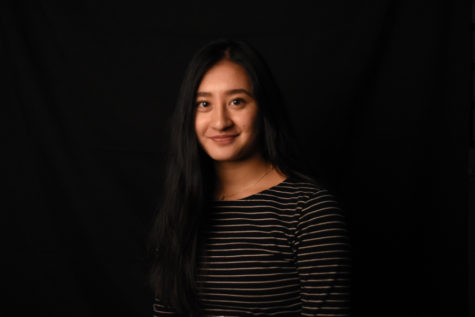Junior Tina Tang and senior Anna Worpvik spent the last three months on foreign soil, learning about and experiencing the American culture firsthand during their exchange periods. Tang will be here for a first semester; while Worpvik will be here for the full year.
“I wanted to experience something new and just get to know a lot of people and the culture. I wanted to learn a language and just have the high school experience,” Worpvik said.
Worpvik is from Norway and will be spending her senior year at West, taking classes that will count towards her education back home.
“Sometimes if foreign exchange students take specific classes here they can count this year as a year of their high school studies, depending on the program they use for the exchange,” counselor Jen Spotanski said . “A lot of times the programs will want them to take U.S. History and Government. They also like them to take an English class and a math class. Those are generally the classes the students are required to take, but not always.”
Tang, from Hong Kong, is more focused on the experience of the trip as her classes are not for high school credit.
“Tina is coming for the experience. She actually has to go back and still complete two years of high school; her junior and senior years. As students come here, it depends on the exchange program they are participating in as to whether they will get credit for the classes they take,” Spotanski said.
Spotanski is both girls’ counselor for the duration of their stay and was involved in helping the girls settle in when they first arrived.
“We usually find out [who our exchange students will be] towards the end of summer—usually mid-to end of July. Then the counselor of the student is notified by Dr. Mitchell. We will contact the family once the student is registered into the system. It really depends on the student and when they arrive, but we usually try to get that last bit done quickly so that they can have greater success,” Spotanski said.
Sometimes the foreign exchange students will arrive before the school year starts, like Worpvik.
“I’m going to travel a lot. I’m going to Florida and San Diego and New York. I’ve been to Minnesota. What I wanted to see when I came to the U.S. was just different parts, which I get to do,” Worpvik said.
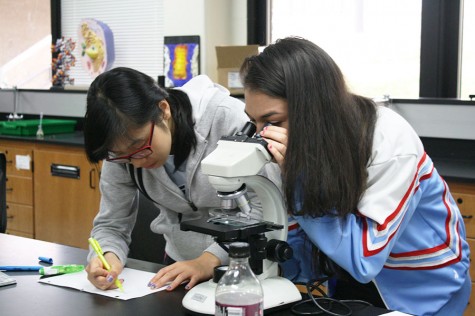
Junior Tina Tang and her lab partner junior Breahna Lopez study hair samples in Forensics.
In their free time, both girls have gotten to see a little of St. Louis as well.
“I have seen the Arch, the zoo, and went to a baseball game. We lost, but it was exciting. Sitting in the stadium with all the people is much different from watching it on TV,” Tang said.
Tang will also be experiencing another first in the coming months.
“I’m really excited to go ice skating. I’ve also never seen snow before so I’m excited to experience all that,” Tang said.
Besides weather differences, both have noted significant differences in culture. For Tang, it is the interpretation of appearances.
“In my country weight is a good thing. When people gain weight, we ask them if life is going well. Here gaining weight is not a good thing,” Tang said.
The number of options available when shopping was the biggest difference for Worpvik.
“Our grocery stores are not that big. They are so much smaller. When you try to find milk here, you have a hundred different options; which is ridiculous,” Worpvik said.
With all the “ridiculous” amount of options, both girls have gotten the chance to take on a class or two that they would not have been able to take at home; like Worpvik is taking piano and psychology.
“Here I get to take fun classes, like forensic science. I don’t have that option at home,” Tang said.
Tang and Worpvik are not the only ones learning about new things.
“I think it’s a learning experience that is reciprocal for both parts,” Spotanski said. “We learn from the culture that they bring to us, as well as they learn a lot of our American culture. The learning takes place on both ends and that it’s a very dynamic learning experience for all of us.”

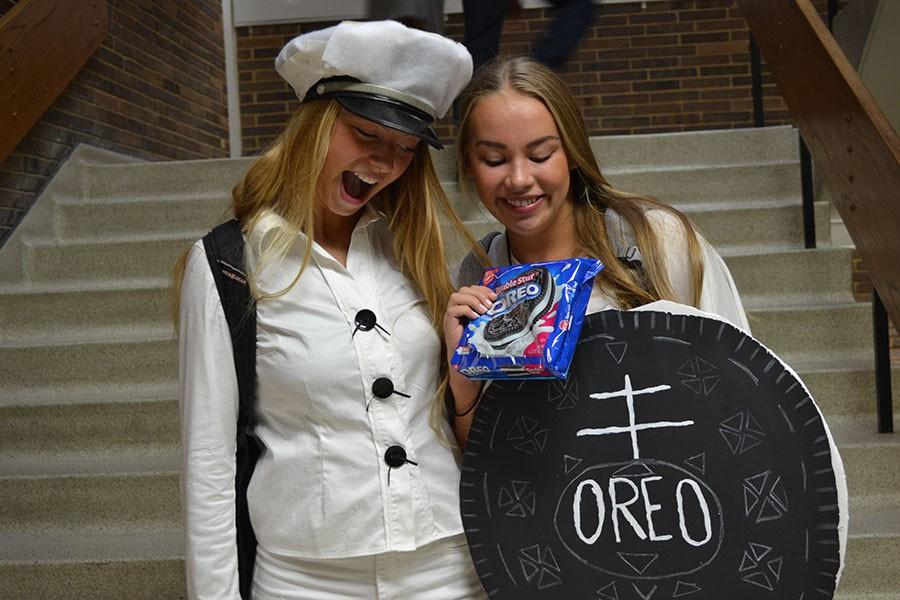
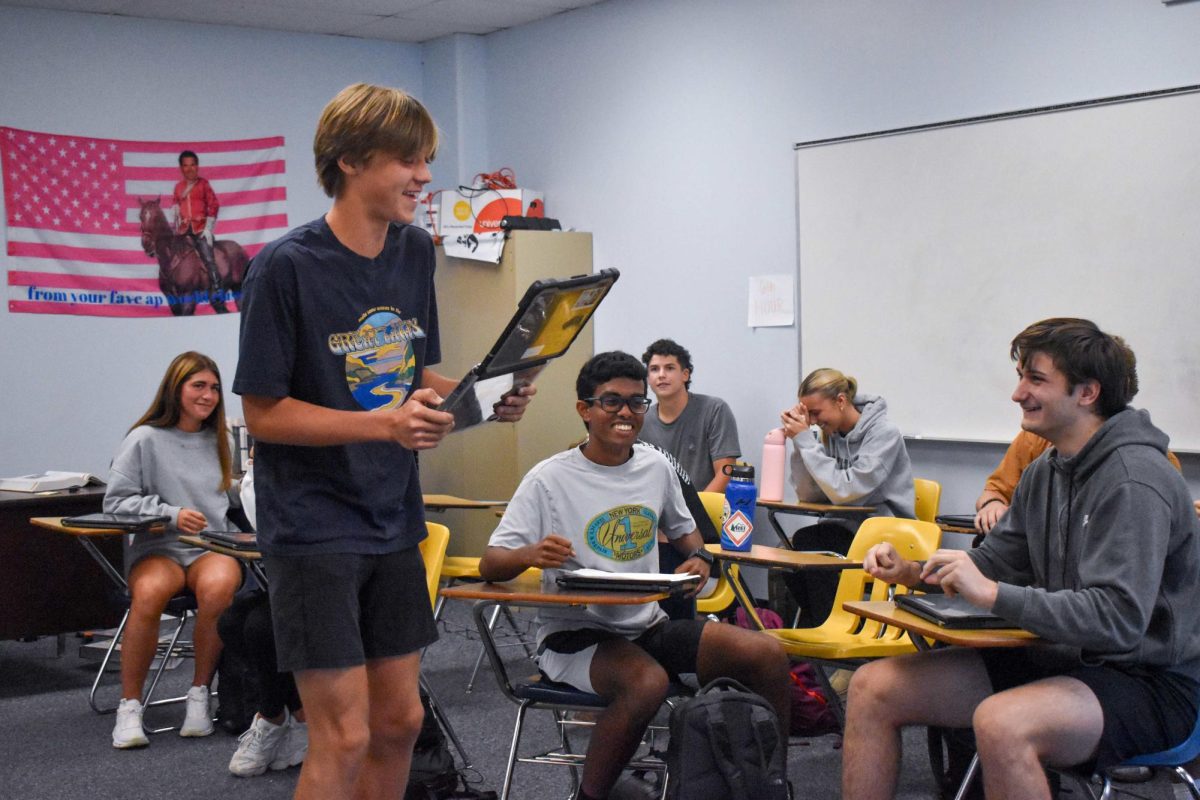
![Freshman Daphne Stokes looks at a table with Veterans Day flyers and information on Nov. 11. Stokes, along with other West High students, like senior Alexander Lewinski, passed by the table in the cafeteria with army recruitment information and giveaways for students to observe during lunch. “Talking with [the recruiters] has definitely helped me [find] where I wanted to go, more than anything else,” Lewinski said.](https://pwestpathfinder.com/wp-content/uploads/2025/11/DSC_1227-2-1200x800.jpg)
![Helping a customer, print room assistant Gretchen Williams operates her booth at the West High Craft Fair from Oct. 25-26. This was Williams’ first time participating in the Craft Fair with her new craft shop, Gs Beaded Boutique. “People have always said, over the years, ‘you should open something.’ [I replied that] I would rather just make [my crafts as] gifts for people. I just started [the online store] up, and it's been okay. I'm always surprised [by] how many views I get and [the] people from different states buying things; somebody from Alaska bought something the other day.”](https://pwestpathfinder.com/wp-content/uploads/2025/11/DSC0451-2-1200x799.jpg)
![Gesturing toward the club’s name on the board, Global Youth Aid co-president year Daniah Alsagheer discusses upcoming service projects with members during a meeting on Oct. 30. “We might be one club at one school, but together, we’re [part of] something much bigger,” Alsagheer said.](https://pwestpathfinder.com/wp-content/uploads/2025/11/DSC00949-1200x800.jpg)
![Focused on providing exceptional service, sophomore Darsh Mahapatra carefully cleans the door of a customer’s car. Mahapatra has always believed his customers deserve nothing less than the best. “[If] they’re trusting us with their car and our service, then I am convinced that they deserve our 100 percent effort and beyond,” Mahapatra said.](https://pwestpathfinder.com/wp-content/uploads/2025/10/DSC_0018-1200x800.jpg)
![Sophomore Aleix Pi de Cabanyes Navarro (left) finishes up a soccer game while junior Ava Muench (right) warms up for cross country practice. The two came to Parkway West High School as exchange students for the 2025-2026 school year. “The goal for the [exchange] program is to provide opportunities for both Parkway students and our international exchange students to learn about other cultures, build connections and become confident, capable, curious and caring — Parkway’s Four C’s — in the process,” Exchange Program Lead Lauren Farrelly said.](https://pwestpathfinder.com/wp-content/uploads/2025/10/Feature-Photo-1200x800.png)

![Gazing across the stage, sophomore Alexis Monteleone performs in the school theater. The Monteleone family’s band “Monte and the Machine” has been releasing music since 2012, but Alexis started her own solo career in 2024 with the release of her first single, Crying Skies. “My whole family is very musical, [and I especially] love writing [songs with them],” Monteleone said.](https://pwestpathfinder.com/wp-content/uploads/2025/09/DSC7463-1200x798.jpg)
![Amid teaching a lesson to her AP Calculus BC class, Kristin Judd jokes alongside her students in their funny remarks. Judd has always enjoyed keeping the mood light in her classroom, along with on the volleyball court. “[I enjoy] that side talk where you see [or] overhear a conversation and chime in, or somebody says something funny,” Judd said.](https://pwestpathfinder.com/wp-content/uploads/2025/09/image-1200x730.jpg)
![Eyeing the ball, junior Ella McNeal poses for her commitment pictures at Clemson University. McNeal’s commitment comes after months of contact with top Division 1 soccer programs. “ It has taken a lot to get to where I am, but I know that [what] I've already been through is just the beginning, and I can't wait for what is to come,” McNeal said.](https://pwestpathfinder.com/wp-content/uploads/2025/09/IMG_4926-1200x900.jpeg)
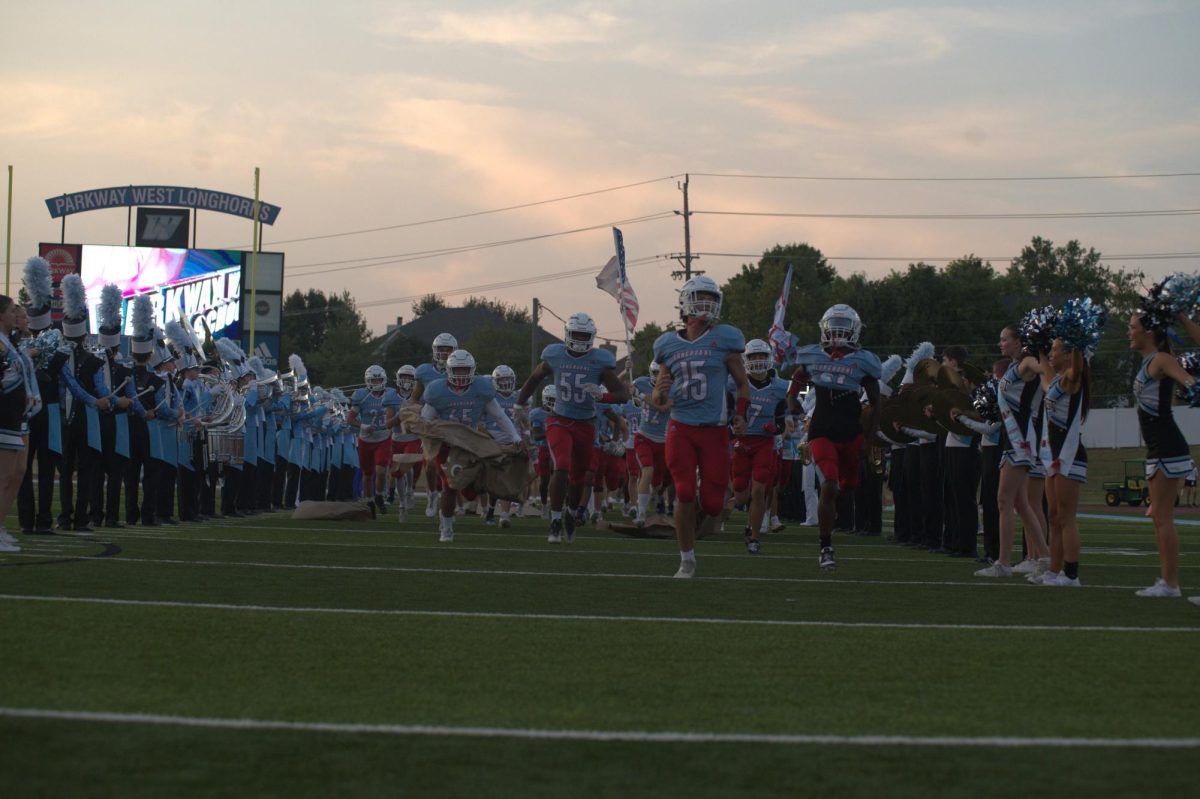
![Sophomore Shree Sikkal Kumar serves the ball across the court in a match against Lindbergh. Sikkal Kumar has been a varsity member of the varsity girls’ tennis team for two years, helping her earn the number two rank in Class 2 District 2.“When matches are close, it’s easy to get nervous, but I [ground] myself by[staying] confident and ready to play,” Sikkal Kumar said.](https://pwestpathfinder.com/wp-content/uploads/2025/11/DSC2801-1200x798.jpg)
![Dressed up as the varsity girls’ tennis coach Katelyn Arenos, senior Kate Johnson and junior Mireya David hand out candy at West High’s annual trunk or treat event. This year, the trunk or treat was moved inside as a result of adverse weather. “As a senior, I care less about Halloween now. Teachers will bring their kids and families [to West’s Trunk or Treat], but there were fewer [this year] because they just thought it was canceled [due to the] rain. [With] Halloween, I think you care less the older you get,” Johnson said.](https://pwestpathfinder.com/wp-content/uploads/2025/10/DSC00892-1-1200x800.jpg)
![Leaning on the podium, superintendent Melissa Schneider speaks to Parkway journalism students during a press conference. Schneider joined Parkway in July after working in the Thompson School District in Colorado. “My plan [to bond with students] is to get things on my calendar as much as possible. For example, being in [classes] is very special to me. I am trying to be opportunistic [meeting] kids [and] being in [the school] buildings. I have all the sports schedules and the fine arts schedules on my calendar, so that when I'm available, I can get to them,” Schneider said.](https://pwestpathfinder.com/wp-content/uploads/2025/09/IMG_5425-1200x943.jpeg)

![Leaping through the air, senior Tyler Watts celebrates his first goal of the season, which put the Longhorns up 1-0 against the Lafayette Lancers. Watts decided to play soccer for West for his last year of high school and secured a spot on the varsity roster. “[Playing soccer for West] is something I had always dreamed of, but hadn’t really had a good opportunity to do until now. It’s [really] fun being out [on the field], and I’m glad I decided to join the team. It’s just all about having fun with the boys and enjoying what time we have left together,” Watts said.](https://pwestpathfinder.com/wp-content/uploads/2025/09/DSC_1951-1200x855.jpg)

![Shifting global trade, President Donald Trump’s tariffs are raising concerns about economic stability for the U.S. and other countries alike. “[The tariffs are] going to pose a distinct challenge to the U.S. economy and a challenge to the global economy on the whole because it's going to greatly upset who trades with who and where resources and products are going to come from,” social studies teacher Melvin Trotier said.](https://pwestpathfinder.com/wp-content/uploads/2025/05/MDB_3456-1200x800.jpg)

![Pitching the ball on Apr. 14, senior Henry Wild and his team play against Belleville East. Wild was named scholar athlete of the year by St. Louis Post-Dispatch after maintaining a high cumulative GPA and staying involved with athletics for all of high school. “It’s an amazing honor. I feel very blessed to have the opportunity to represent my school [and] what [it] stands for,” Wild said.](https://pwestpathfinder.com/wp-content/uploads/2025/05/unnamed-6-1200x714.jpg)
